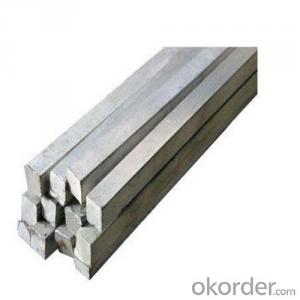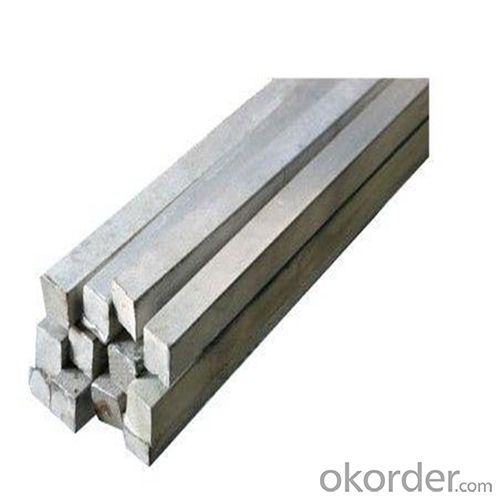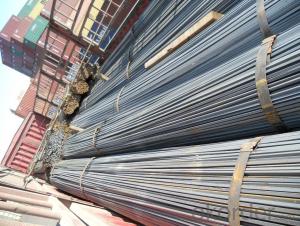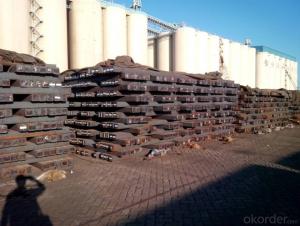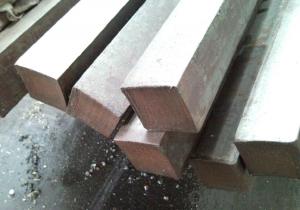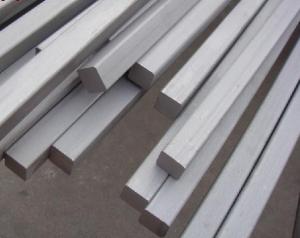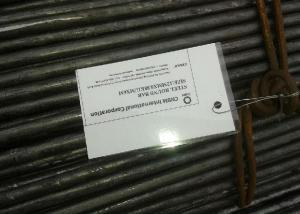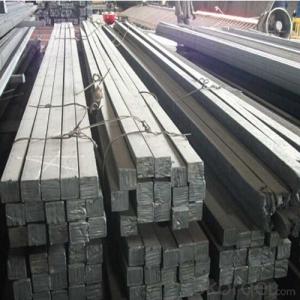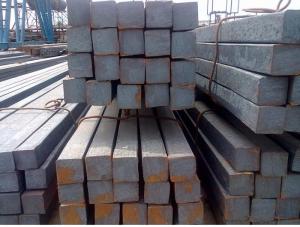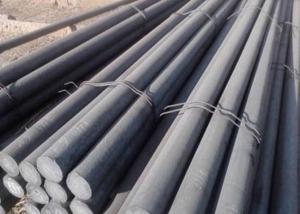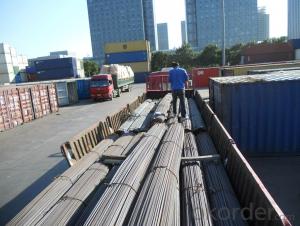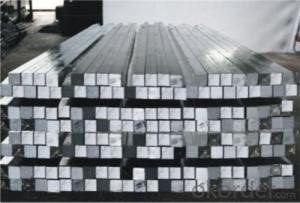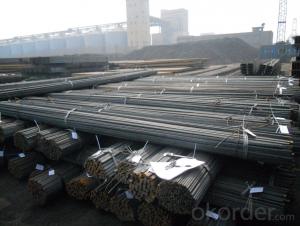Steel Square Straight Bars Chinese Standard
- Loading Port:
- Tianjin
- Payment Terms:
- TT OR LC
- Min Order Qty:
- 25 m.t.
- Supply Capability:
- 1000 m.t./month
OKorder Service Pledge
OKorder Financial Service
You Might Also Like
1. Structure of Steel Square Straight Bars Chinese Standard Description:
Steel square straight bars Chinese standard is a bar with square shaped cross-section. It is special case of equal sides. Before steel products are sold on the market, the steel must first be processed into more functional pieces. Raw steel cannot be of use while in its pure form, thus it has to be cast into shape. The freshly made steel, steel square straight bars Chinese standard is still in the form of a metal bar or rectangle. Small sizes of Steel square straight bars Chinese standard are used in ship building.
2. Main Features of Steel Square Straight Bars Chinese Standard :
• Grade: Q235
• Type: Mild carbon steel
• A quadrilateral with four equal sides and four right angles.
• Vibration: The stiffness and mass are chosen to prevent unacceptable vibrations, particularly in settings sensitive to vibrations, such as offices and libraries.
• Local yield: Caused by concentrated loads, such as at the beam's point of support.
3. Steel Square Straight Bars Chinese Standard Images:
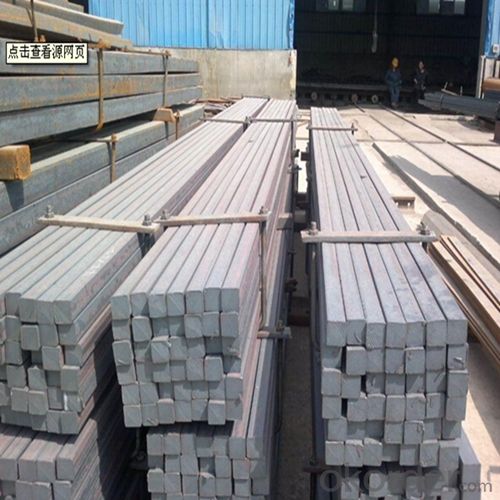
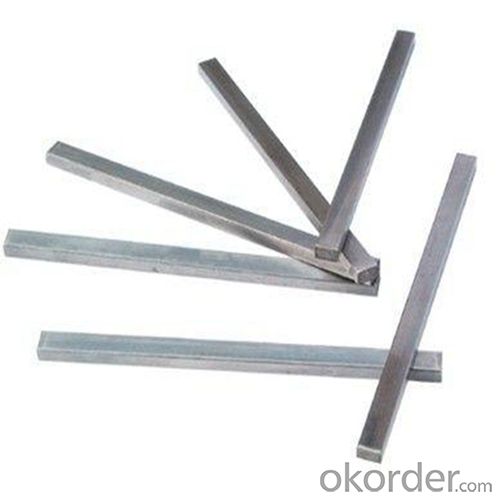
4. Steel Square Straight Bars Chinese Standard Specification:
Mechanical Properties | Grade | Steel diameter(mm) | |||
≤16 | 16~40 | 40~60 | 60~100 | ||
Yield Point Δs/MPa | Q195 | ≥195 | ≥185 | - | - |
Q235 | 235 | 225 | 215 | 205 | |
Tensile Strength | Q195 | 315~390 | |||
Q235 | 375~500 | ||||
Elongation δ5% | Q195 | ≥33 | ≥32 | - | - |
Q235 | 26 | 25 | 24 | 23 | |
5. FAQ
We have organized several common questions for our clients,may help you sincerely:
①What is the main material?
There are two types of Square Bar, one is hot rolled square bar and other one is cold drawn square bar. Our principal products is hot rolled square bar. We dedicate to products with material Q195 and Q235. We offer products with high quality and low price.
②How to inspect the quality?
We have a professional inspection group which belongs to our company. We resolutely put an end to unqualified products flowing into the market. At the same time, we will provide necessary follow-up service assurance.
③Is there any advantage about this kind of product?
Steel I beam bar IPE has a reduced capacity in the transverse direction, and is also inefficient in carrying torsion, for which hollow structural sections are often preferred.
- Q: The steel structure material can do?
- Yes, if you are easy to do, you can
- Q: Can a steel square be used for checking the flatness of concrete slabs?
- A steel square is not suitable for checking the flatness of concrete slabs. Although it is effective for measuring angles and ensuring square corners, it is not intended for assessing surface flatness. To accurately determine the levelness and flatness of concrete slabs, specific tools such as a straightedge or a laser level are recommended. These tools offer a more precise and reliable method for evaluating whether a concrete slab is level and flat.
- Q: Can a steel square be used for checking the alignment of wall cabinets?
- Yes, a steel square can be used for checking the alignment of wall cabinets. A steel square, also known as a framing square or a carpenter's square, is a versatile tool commonly used by carpenters and construction professionals for measuring and checking right angles. To use a steel square for checking the alignment of wall cabinets, you can place it against the corner of the cabinet and use it to ensure that the cabinet is square and properly aligned. The straight edges of the steel square can be used to check that the sides of the cabinet are parallel and straight. Additionally, the inside edge of the steel square can be used to verify that the corners are at 90-degree angles. Overall, a steel square can be a useful tool in ensuring the proper alignment of wall cabinets during installation.
- Q: Can a steel square be used for checking the squareness of a router table top?
- Yes, a steel square can be used for checking the squareness of a router table top. A steel square is a commonly used tool for checking squareness and can provide accurate measurements. It can be placed against the edges of the table top to ensure that they are perpendicular to each other. By comparing the squareness of the table top with the steel square, any deviations or misalignments can be easily identified. This is essential for ensuring the precision and accuracy of the router table, as a perfectly square table top is crucial for achieving accurate and consistent cuts.
- Q: How do you use a steel square to measure the height of a door opening?
- To measure the height of a door opening using a steel square, follow these steps: 1. Hold the steel square vertically against the side of the door opening, making sure that the door frame aligns with the long side of the square. 2. Ensure that the square is positioned in a way where one of its edges is in line with the floor or any other reference point you prefer as a starting point. 3. Slide the square upwards along the door frame until the other edge of the square reaches the top of the door opening. 4. Once the square is in place, examine the markings on its vertical edge. These markings indicate measurements in inches or centimeters. 5. Take note of the measurement where the top edge of the door opening aligns with the square. This measurement represents the height of the door opening. 6. Repeat the process on the opposite side of the door opening to ensure accuracy. If there are slight variations in the measurements, calculate the average for a more precise result. Using a steel square to measure the height of a door opening offers a straightforward and reliable method for obtaining accurate measurements for diverse purposes, such as installing a new door or ordering a customized one.
- Q: How do you use a steel square to mark angles?
- To use a steel square to mark angles, you would typically position one arm of the square along the reference edge of the material you are working with. Then, you would slide the other arm of the square until it aligns with the desired angle, using the markings on the square as a guide. Once the square is properly aligned, you can use a pencil or scribe to mark the angle on the material, ensuring accurate and precise measurements.
- Q: How do you use a steel square to determine the slope of a roof valley?
- To use a steel square to determine the slope of a roof valley, follow these steps: 1. Start by positioning yourself at the bottom of the valley, where the two roof slopes meet. Make sure you have a clear view of the entire valley. 2. Hold the steel square horizontally, with one of its edges aligned with the bottom edge of the roof slope on one side of the valley. Ensure that the square is firmly in place. 3. Look at the scale on the steel square, which is usually marked in inches or centimeters. Locate the line on the square that aligns with the roof slope on one side of the valley. 4. Now, without moving the steel square from its initial position, look at the roof slope on the other side of the valley. Observe the point where the roof slope intersects the steel square's scale. 5. Measure the distance from the bottom edge of the roof slope on one side of the valley to the point where the roof slope on the other side of the valley intersects the steel square's scale. This measurement will give you the rise of the roof valley. 6. Next, measure the horizontal distance between the two roof slopes at the bottom of the valley. This will give you the run of the roof valley. 7. To determine the slope of the roof valley, divide the rise by the run. This can be done by dividing the measurement obtained in step 5 by the measurement obtained in step 6. For example, if the rise of the valley is 4 inches and the run is 12 inches, the slope would be 4/12 or 1/3. This means that for every 3 units of horizontal distance, the roof valley rises 1 unit. By using a steel square and following these steps, you can accurately determine the slope of a roof valley, which is crucial for proper installation and maintenance of roofing materials.
- Q: How do you use a steel square to determine angles for picture hanging?
- In order to determine angles for picture hanging using a steel square, it is necessary to follow a few straightforward steps. To begin, select a desired reference point on the wall where you wish to hang the picture. This reference point can be the center or any other specific location of your preference. Next, position the steel square against the wall, making sure that one of its edges aligns with the chosen reference point. This particular edge will serve as the baseline for measuring the angles. Once the square is properly aligned, place a level on top of the square. By doing this, you can ensure that both the square and the baseline are perfectly horizontal. With the level in place, you can now determine the desired angle for your picture. Gradually tilt the square either upwards or downwards until you achieve the desired angle on the level. It is important to maintain a steady position for both the square and the level during this process. After determining the angle, mark the position on the wall where the baseline intersects with the square. This point indicates where the picture should be hung. Lastly, employ a measuring tape or ruler to measure the distance from the reference point to the marked spot on the wall. This measurement will assist in hanging the picture at the correct height. By following these steps, you can accurately determine the desired angle for picture hanging using a steel square. This ensures that your pictures will be properly aligned and level.
- Q: Can a steel square be used for measuring roofing angles?
- Yes, a steel square can be used for measuring roofing angles. A steel square, also known as a framing square or carpenter's square, is a versatile tool that can be used for a variety of measurements in construction, including roofing angles. Its long body and right angle shape make it ideal for measuring and marking angles accurately. With the help of the steel square, roofers can determine the pitch or slope of a roof, ensuring precise measurements for proper installation and alignment of roofing materials.
- Q: How is a steel square used in woodworking?
- A steel square is a versatile tool used in woodworking for various purposes. It is primarily used for measuring and marking right angles accurately. One common use of a steel square is to check the squareness of a project or workpiece. Woodworkers use it to ensure that the corners of a piece of furniture, such as a table or cabinet, are perfectly 90 degrees. This is crucial for ensuring the stability and overall quality of the finished product. Another way a steel square is used is for laying out and marking angles. By placing the square against the edge of a piece of wood, woodworkers can easily mark precise angles of 45 degrees, 30 degrees, or any other desired angle. This is particularly useful when cutting or joining wood pieces at specific angles, such as when building frames or joints. Additionally, a steel square can be used as a guide for making straight and accurate cuts. By aligning the square along the edge of the wood and running a saw or other cutting tool against it, woodworkers can ensure that their cuts are perfectly perpendicular to the surface. This is especially important for making clean and precise cuts, whether it's for creating joints or sizing lumber. Overall, a steel square is an indispensable tool in woodworking. It aids in achieving accuracy and precision in measuring, marking, and cutting wood, ensuring that the finished project is of high quality and meets the required specifications.
Send your message to us
Steel Square Straight Bars Chinese Standard
- Loading Port:
- Tianjin
- Payment Terms:
- TT OR LC
- Min Order Qty:
- 25 m.t.
- Supply Capability:
- 1000 m.t./month
OKorder Service Pledge
OKorder Financial Service
Similar products
Hot products
Hot Searches
Related keywords
